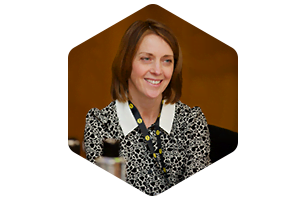
Liam Heraty
Head of Content
The Finance Hive

Grainne O’Connor
Senior Equity Trader
Fidelity International
2022 will be remembered as a year when out of control inflation triggered the fastest rate hiking cycle in recent history.”
Not only did we have to be dynamic, nimble, and quick in our thinking as we grasped liquidity opportunities, but we also had to understand the operational implications of settlement in trading with allowable counterparts.”
“50% of our tickets are now automated, this is less than 5% of our dollar nominal traded. These are small tickets where traders do not add any value. Automation can give you time, and time for me is the most valuable commodity.”
It’s about patience, discipline, access to liquidity venues and specialised broker relationships to ensure discreet and best outcome for clients!”
But it’s also in years like 2022, that it becomes more clear than ever how important it is for traders to continue to educate our PMs about the cost of trading and liquidity opportunities.”
On a more positive note, it’s good to see the easing of limits on dark pools and SI’s, though we need to pay attention to any potential liquidity divergence between the UK and European venues.”
Communication is key along with collaboration, discussing ideas and encouraging efficiencies, but in particular, working in a team where everyone feels they have a seat at the table.”
Why was 2022 so difficult compared to previous years?
GO: 2022 will be remembered as a year when out of control inflation triggered the fastest rate hiking cycle in recent history. Last year is hailed as the worst year for stocks since the 2008 GFC and the worst years ever for bonds with correlation between the 2 asset classes having never been higher. As a result, we saw a lot more volatility, wider spreads, less liquidity and the cost of trading increased.
To start the year, we’re presented with high geo-political tensions between Russia and Ukraine, which unfortunately become a reality in Q1. While volumes were elevated during that period, liquidity started to drain pretty quickly in Russia local and GDRs, as investors looked to risk manage their exposure to Russia which was one of the most liquid markets for EM geographies.
Did these challenges change your relationship with liquidity?
GO: To overcome these challenges, and especially with the EM liquidity shutters coming down in front of our eyes, we had to be bold and brave in our approach. Not only did we have to be dynamic, nimble, and quick in our thinking as we grasped liquidity opportunities, we also had to understand the operational implications of settlement in trading with allowable counterparts. It was imperative to keep communication lines open with all stakeholders – risk management, valuation teams, GEM PMs, senior management as well as our counterparties. It was important to keep a cool and collective composure not only for yourself but also to ensure the same for the rest of the team.
Developed European sectors were also impacted given the reliance on energy from Russia, which helped fuel the inflation and hiking debacle. Liquidity is always an issue, as a HT trader our pads are full of many small and mid-cap illiquid situations. Given the market volatility, we saw wild moves in some of our names, which can be an opportunity but also can be really tricky to work through. It’s about patience, discipline, access to liquidity venues and specialised broker relationships to ensure discreet and best outcome for clients.
How did all of this affect your relationships with internal and external stakeholders?
GO: As the challenges of 2022 continued throughout the year with a direct impact on liquidity, volatility, performance and cost of trading. Our relationships with all our stakeholders were really put to the test.
As a trader we naturally keep communication lines open across all stakeholders. It was imperative that we kept our PMs updated with liquidity opportunities, any limitations (in terms of brokers who couldn’t trade GDRs during the initial days of the Russian invasion of Ukraine) and operational impacts on how securities will clear. Broker relationships were key in helping us manage our risk where we could, and whilst most were under a lot of pressure they really worked hard over those few weeks.
But it’s also in years like 2022, that it becomes more clear than ever how important it is for traders to continue to educate our PMs about the cost of trading and liquidity opportunities so that end investors receive the best outcome for the funds, in minimising execution costs. Essentially, we solidified lots of relationships resulting in positive outcomes across the board.
With the difficulties of 2022 hopefully behind us, what market structure and regulatory challenges are you most aware of in 2023?
GO: For me it’s the continued debate on consolidate tape between the UK and European regulators and how that progresses – however, it feels slow moving and only a post trade tape is currently being proposed. On a more positive note, it’s good to see the easing of limits on dark pools and SI’s, though we need to pay attention to any potential liquidity divergence between the UK and European venues. It will be interesting to also see how t+1 settlement plays out in the US and if there will be similar plans in UK and Europe post the US migration.
What does your technology strategy look like for 2023, and how can it help the ‘bounce back’?
GO: We’re looking to improve our operating efficiency and reduce complexity in our workflows through automation and the use of data. The stronger our data, the more we can look to enhance our electronic strategies for various flow types and outcomes. We’re also looking to drive efficiencies across our workflow in enhancing those processes for scalability and alpha generation opportunities.
What are the key skill sets needed in traders now, and how are you enabling your teams to be successful going forward?
GO: Communication is key along with collaboration, discussing ideas and encouraging efficiencies, but in particular working in a team where everyone feels they have a seat at the table. We really want to encourage innovation of ideas and solutions.
To that point, we are looking to use and interpret data in various new and novel ways with different stakeholders that can really enhance an outcome such as our brokers, investors, PMs on execution performance, liquidity strategies, etc.
Finally, what advice can you give other buy side on how to bounce back in 2023?
GO: Enjoy what you do; focus on teamwork and support – and embrace challenges as opportunities, look for efficiency gains, however small they may be, everything helps the bottom line! Understand the power of data, and finally, continue/start to network!
